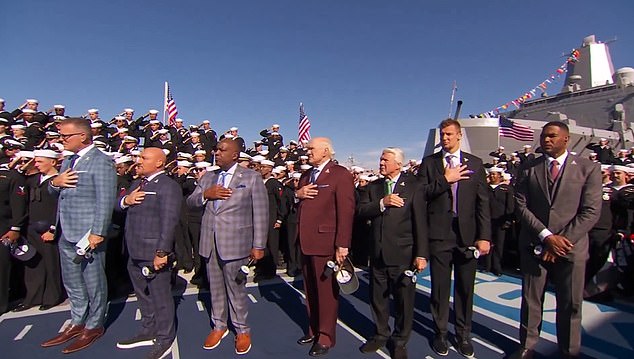Last weekend, Michael Strahan became the latest sports figure to find themselves in hot water for their behavior during the national anthem.
While the former New York Giants star and FOX NFL analyst took in the ‘Star Spangled Banner’ at the San Diego Naval Base, he had his hands by his waist – rather than placing one on his heart as the rest of his TV colleagues did.
Some NFL fans blasted the Super Bowl winner for ‘disrespecting’ the military on Veterans Day, while ex-Green Beret and NFL player Nate Boyer dismissed the notion that Strahan had acted out of order.
Strahan, whose father Gene served 23 years in the army, shared an Instagram story on Monday thanking service members and separately explained his reasoning for not putting his hand over his heart.
‘If you want the truth, I’ll tell you the truth… it’s that I was caught up in the moment,’ he said in an Instagram video.
‘I’m looking at all these young sailors standing there at attention before the national anthem played and I’m thinking to myself, ‘How incredible to be that young and to know that you wanna do this. It’s such a commitment but you’re willing to commit to something that gives us our freedoms. Plain and simple.’
Michael Strahan (right) has been criticized for not placing his hand over his heart during the national anthem on Sunday
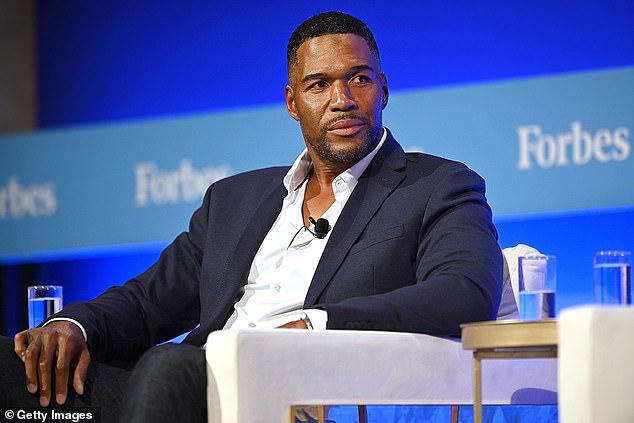
Strahan’s father served 23 years in the army and he insisted he was ‘caught up in the moment’
While the Strahan controversy looks set to die down, given that Fox Sports will not be fining or punishing him, he’s far from the first athlete to make headlines surrounding the anthem.
In fact, his apparently honest mistake pales in comparison to the full-fledged protests we have seen from the likes of other sports figures over the years.
From Colin Kaepernick to Megan Rapinoe and more, here are some of the most memorable national anthem controversies and demonstrations.
Colin Kaepernick
The most notable anthem controversy in recent years involved the former 49ers quarterback Kaepernick, who began refusing to stand for the national anthem in 2016.
After sitting during a preseason game, Kaepernick explained that he was protesting because the United States ‘oppresses black people and people of color.’
He continued to NFL Media that ‘…this is bigger than football and it would be selfish on my part to look the other way. There are bodies in the street and people getting paid leave and getting away with murder.’
The quarterback continued protesting the anthem throughout the 2016 season, though he began kneeling rather than sitting after Boyer suggested he do so.
Other NFL players, including his San Francisco teammate Eric Reid, began kneeling as well, and the issue became so big that then-President Barack Obama sounded off, defending his right to protest.

Colin Kaepernick began kneeling during the national anthem during the 2016 NFL season
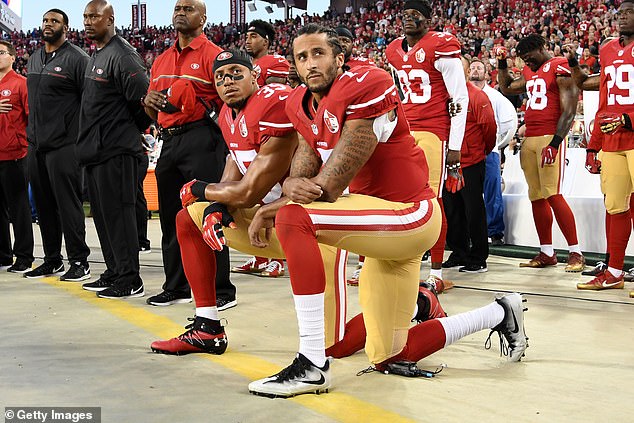
He was joined in his protest against racial inequality by 49ers teammate Eric Reid
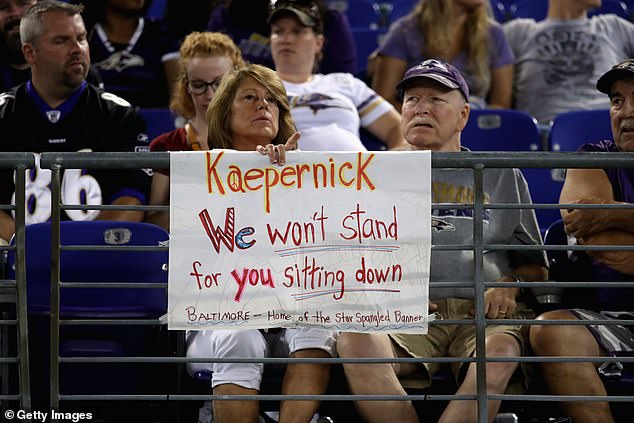
Kaepernick’s peaceful protest was widely criticized by NFL fans and politicians alike
Kaepernick was also indirectly criticized by Donald Trump, at that point a first-time presidential candidate, who at a 2017 rally referred to a player who kneels during the anthem as a ‘son of a b****.’
Ultimately, Kaepernick – who led the 49ers to the Super Bowl in 2013 – would never appear in the NFL again after opting out of his contract in March 2017.
Reid, a one-time Pro Bowler, also went unsigned from the end of the 2017 season until September 2018, when he was finally signed by the Panthers.
He and Kaepernick filed collusion grievances against the league, alleging that the NFL and its owners blackballed them following their protests.
The NFL settled both of those grievances in 2019.
The league also approved a rule a year prior banning kneeling during the anthem, though the measure was quickly scrapped.
Megan Rapinoe
The outspoken Rapinoe also became the target of outrage in 2016 when she followed Kaepernick’s lead and kneeled during the national anthem before an NWSL game in Chicago.
She did so again before US women’s national team games against Thailand and the Netherlands.
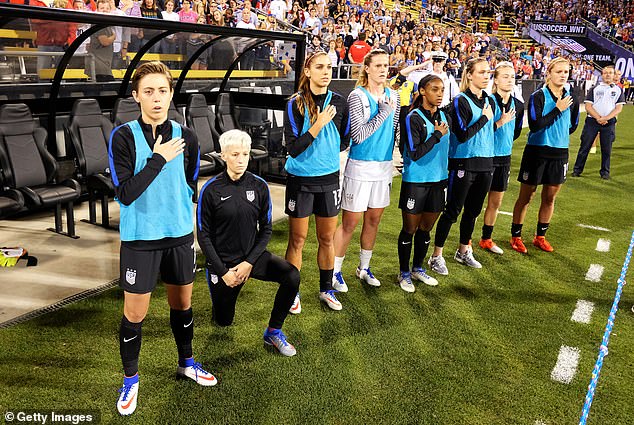
US women’s national team star Megan Rapinoe followed Kaepernick’s lead and also began kneeling during the anthem

She resumed standing in later years but stayed silent and did not sing the anthem
Rapinoe also stopped singing the national anthem that year.
In her book ‘One Life,’ she explained how she told journalists her protest was ‘to draw attention to white supremacy and police brutality.
‘White people were mad. Whew, were they mad!,’ an excerpt from The Guardian read. ‘Conservative commentators in the media immediately started shouting and yelling that kneeling during the anthem disrespected the military.’
US Soccer later implemented a rule that prohibited players from kneeling during the anthem, though it reversed course in 2020.
While Rapinoe returned standing for the anthem in later years, she continued protesting the anthem by not singing and placing her hands behind her back.
Many of her USA teammates also remained silent during the anthem at the 2023 Women’s World Cup.
Rapinoe played her final game for the USWNT later that year, and continued her protest one final time before a game against South Africa.
Mahmoud Abdul-Rauf
Before Kaepernick and Rapinoe, Abdul-Rauf was the most prominent pro athlete in America to protest during the national anthem.
A converted Muslim born Chris Jackson, Abdul-Rauf changed his name in 1993 and was later suspended for a game in 1996 for refusing to stand for the national anthem.
Abdul-Rauf, a Nuggets guard who was also fined close to $32,000 by the league for the act, called the American flag ‘a symbol of oppression, of tyranny.’
‘I became a Muslim and I began to read more than I’ve ever read before,’ he later told TODAY.
‘But as I’m reading, you know, whether it’s foreign policy, domestic policy, I’m seeing America’s hand in so much corruption. And then I’m looking also at the history of this nation. Slavery and Jim Crow and segregation, right? I can’t reconcile standing up for this symbol, right? I just can’t.’

Mahmoud Abdul-Rauf stands in prayer during the singing of the anthem in 1996
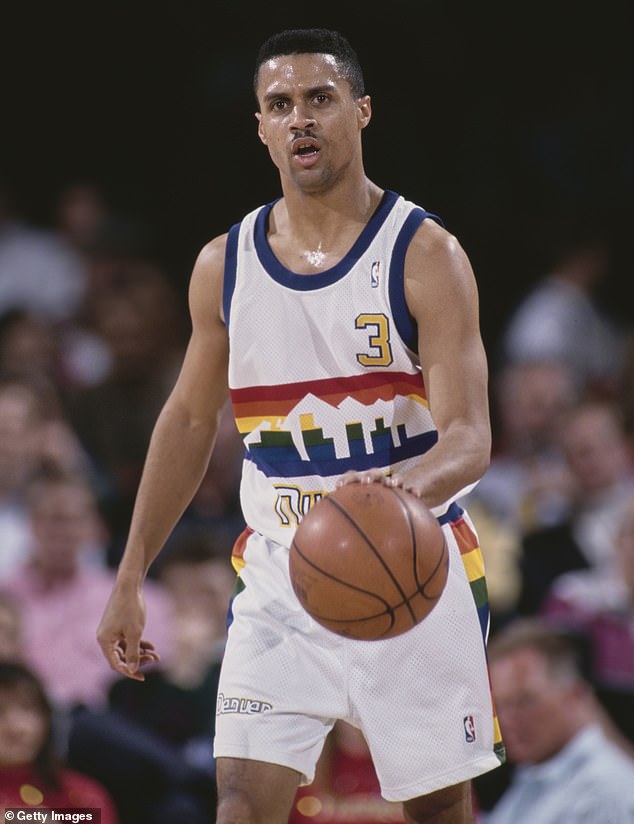
Abdul-Rauf was traded away from the Nuggets after the 1995-96 season and didn’t last much longer in the NBA
Following his suspension, Abdul-Rauf agreed to stand for the anthem, but could be seen bowing his head in prayer.
The career 14.6 point per game scorer ultimately suffered a similar fate to Kaepernick, as he was traded to the Kings following the 1995-96 season and was out of the league two seasons later (before briefly returning for the expansion Vancouver Grizzlies in 2000).
His house also went up in flames in 2001, which he said believed was racially motivated.
2020 Protests
Following the deaths of Breonna Taylor and George Floyd at the hands of police in 2020, athletes across major American sports league protested during the national anthem in response to racial inequality.
In the NFL – four years after Kaepernick’s protests caused controversy – members of many teams chose to demonstrate.
Many chose to kneel or raise their fists during the anthem, with others like the Eagles’ Michael Bennett and Malcolm Jenkins choosing to remain in the locker room altogether.
While some players chose to stand for the flag – and Saints quarterback Drew Brees told Yahoo! Finance that he didn’t agree with people ‘disrespecting the flag’ (which he later walked back) – this wave of protests was largely embraced in the sports world, unlike Kaepernick’s.

Tight end Jimmy Graham raises his fist during the national anthem before a game in 2020
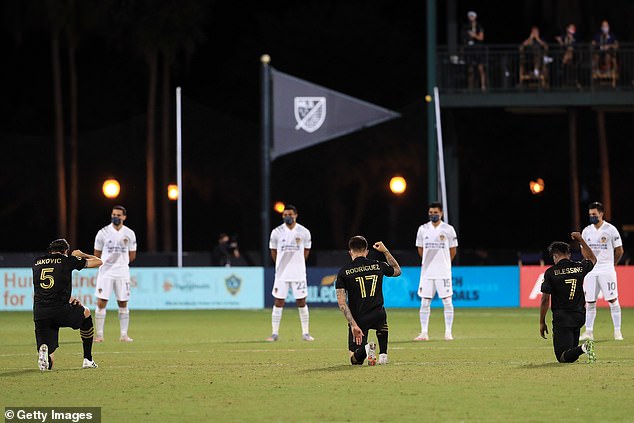
Anthem demonstrations also spread to MLS, as some players took the knee during the anthem
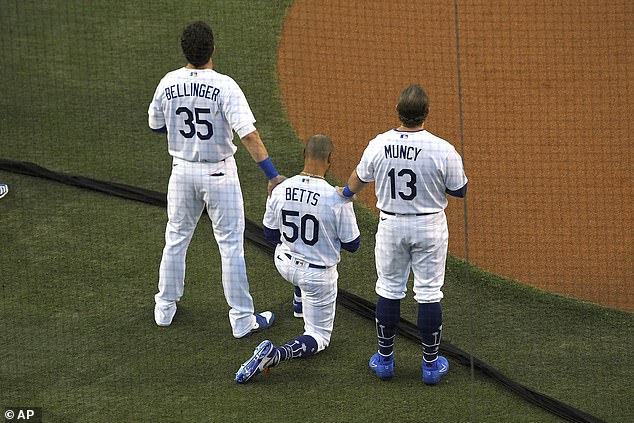
Cody Bellinger and Max Muncy showed their support for Dodgers teammate Mookie Betts by standing beside him with their arms on his shoulders as he kneeled
NFL commissioner Roger Goodell even admitted ‘we were wrong for not listening to NFL players earlier and encourage all to speak out and peacefully protest.’
Demonstrations carried into MLS and MLB as well, as one notable moment showed black Dodgers star Mookie Betts kneeling, while his white teammates Cody Bellinger and Max Muncy stood beside him with their hands on his shoulders.
The 2020 WNBA season also began with players from the Seattle Storm and New York Liberty walking off of the court before the national anthem played.
English Premier League players also routinely took a knee prior to matches after the league resumed from its Covid lockdown in the summer of 2020, while many international teams did the same before games in Euro 2020 the following year.
Jonathan Isaac
With the United States undergoing a summer of racial reckoning in 2020, the Orlando Magic’s Isaac drew attention for not protesting the anthem.
Inside the NBA’s Covid ‘bubble’, Isaac became the first player to stand for the anthem, with many of the league’s players choosing to kneel during this time.
Isaac explained that his faith was a factor in his decision to stand.
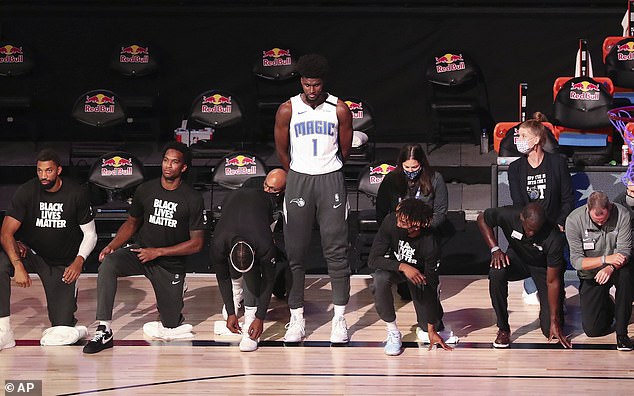
Jonathan Isaac actually drew attention for not kneeling during the 2020 NBA Covid ‘bubble’
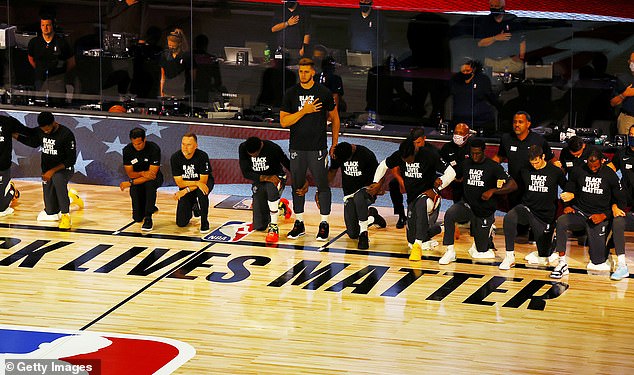
Meyers Leonard also stood for the anthem while his Miami Heat teammates knelt
‘I don’t think that kneeling or putting on a T-shirt for me, personally, is the answer,’ he said, via ESPN.
‘I feel like for me black lives are supported through the Gospel. All lives are supported through the Gospel. That we all have things that we do wrong and sometimes it gets into a place of pointing fingers about which wrong is worse.’
Spurs coach Gregg Popovich and assistant Becky Hammon also stood for the anthem before Isaac, while Blazers player Meyers Leonard stood as well, citing his respect for the military.
Isaac also stood out that summer with his decision not to wear a social justice message on his jersey, like most of his fellow players did.
